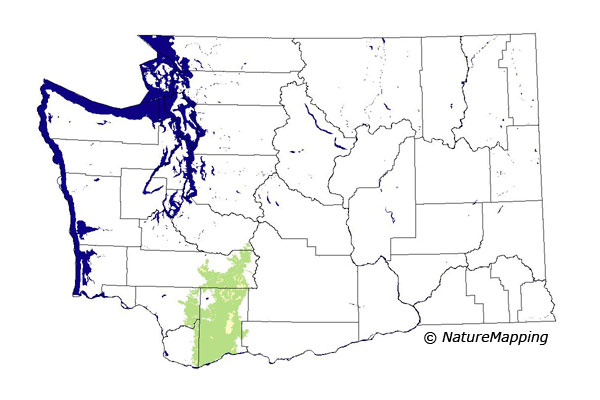GAP Analysis Predicted Distribution Map
Larch Mountain Salamander (Plethodon larselli)
Species Code: PLLA
|
Legend:
 = Core Habitat = Core Habitat
 = Marginal Habitat = Marginal Habitat
Metadata
(Data about data or how the map was made)
Predicted Distribution
Amphibians do not migrate as some birds and mammals, so the colored areas depict the predicted range for the Larch Mountain Salamander year-round. The habitats were identified using 1991 satellite imagery, other datasets and experts throughout the state, as part of the Washington Gap Analysis Project.
Click to enlarge distribution map
|
Distribution and Habitat Requirements
This species was once believed to be confined to the Columbia River Gorge, but recent records demonstrate its occurrence throughout
much of the Southwest Cascades. Most individuals are found on steep talus slopes and within forests with a dense over-story of coniferous trees.
The Larch Mountain Salamander is known to occur in talus in an oak cover type.
The talus substrate is believed to be the most important habitat feature, and any tree type can apparently serve the purpose of providing shade.
Models
The Southwest and Southeast Cascades ecoregions were selected. Douglas-fir, Grand Fir, Low-Elevation Lava Flows, Western Hemlock, Silver Fir and
Subalpine Fir zones were core areas. Oak and Lava Flow zones were marginal habitat.
Riparian areas (areas along rivers and streams) within the range of the Larch Mountain Salamander often include tree cover and steep slopes,
and were therefore modeled as good habitat. In the Southeast Cascades, all classes of open and closed-canopy hardwood, hardwood/conifer and
conifer forests were suitable in appropriate microhabitats existed. In the Southwest Cascades, hardwood forests were excluded.
The range limits included areas in moist forest zones where lava flows and basalt substrates are common.
Translated from the Washington Gap Analysis Amphibians and Reptiles Volume by Karen Dvornich
Webpage designed by Dave Lester

 = Core Habitat
= Core Habitat = Marginal Habitat
= Marginal Habitat